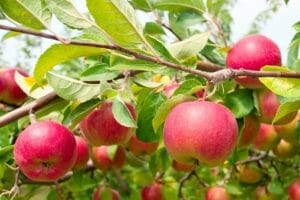Trees are beneficial in so many ways. One of the most direct ways we see their benefits is when they bear us fruit to eat. You not only save a little money by producing food, but there’s nothing tastier than produce fresh from your backyard.
Let’s take a look at some of the keys to caring for a fruit tree.
If you’re looking to plant a new tree, spring is the ideal time, so as of the writing of this blog, you may want to be a little patient. Planting them in spring gives your tree time to establish itself before the winter arrives.
Watering Fruit Trees
While you can water the tree less often when it has an established root system, early on make sure you provide water anytime you see the top couple inches of the surrounding soil is dry. We usually get a lot of help with rain here maintaining fruit trees in Portland, but you need to be extra vigilant in the summer months when we can go through some dry spells.
A juicy fruit crop will depend on regular watering, which means deep soaking. Providing mulch around the base of your tree will help retain moisture as well.
How much watering do you need to do? The water needs to reach about 18 inches below the surface around the drip line (where the branches end). So, shoot for about 30 to 45 minutes of watering, 2 to 3 times a month during growing season, taking into account how much rainfall we are getting.
Pruning Fruit Trees
For the first three years or so, your fruit tree needs to develop structurally. As it matures and you start to see fruit, pruning is all about striking a balance between encouraging fruit development and maintaining the structural integrity of the tree itself.
The optimal time to prune your deciduous fruit trees is in the winter when it’s dormant, which makes it less prone to stress. This should be done annually.
Fertilizing Fruit Trees
How you fertilize your fruit tree largely depends on what fruit it’s bearing. However, just before the buds break on your tree is the best time to fertilize. The amount of fertilizer and frequency of application depends on what tree you’re dealing with. Don’t overdo it, as excess fertilizer can stress your tree.
You can start by locating the previous year’s growth rings on the branches. Measure from that spot to the end of the branch, doing so on several different branches. Take the average length you come up with and compare it to the target growth for the species. The amount of fertilizer, if any, that will be applied depends on the annual growth and species.
This article from Colorado State University provides charts that help calculate the amount of fertilizer you need for your particular tree. If you prefer some personalized attention to your tree care needs or need help selecting the best fruit trees to grow in Portland, give us a call today, we’d be happy to help.
This post first appeared on https://www.urbanforestprofessionals.com